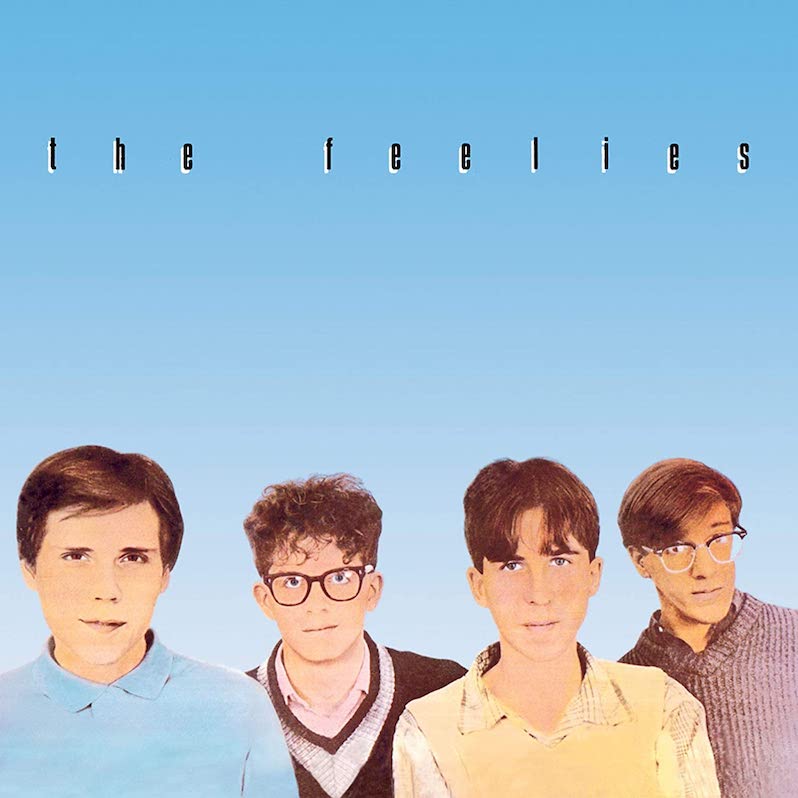Perpetual Nervousness: 30 years of The Feelies’ Crazy Rhythms

Some controversy surrounds the cover art for Weezer’s self-titled debut album and its uncanny resemblance to that of pioneering nerd rockers The Feelies‘ debut album Crazy Rhythms. While some argue that Cuomo’s band of geeks ripping off their seeming progenitors’ appearance somehow reflects on their music being influenced by them, anyone who has considered the innovation and vigor present and bleeding through the 40-plus minutes of Crazy Rhythms will attest that the proof lies in the pudding. I’ll give credit where credit is due; the Blue Album is in fact a rather nice and simple collection of hook-laden, rave-up pop songs and the follow up Pinkerton deserves the gratuitous mention in the labored debate of Weezer’s merits. But an effort to draw parallels between the two bands beyond a penchant for thick rimmed glasses and unkempt hair set in front of a plain blue background seems to me entirely erroneous.
The intention of this article is not in anyway to belittle Weezer or even really to discuss the band for that matter. I used them merely as an example by which to emphasize the immense significance of Crazy Rhythms. That said, the seminal Feelies record is celebrating a landmark anniversary, and the best present I could offer was a sincere homage to the record that channeled the nervous energy of four geeks into a blistering set in which the uncool sounded anything but.
The record kicks off in fretful fashion with the appropriately titled “The Boy With The Perpetual Nervousness” recounting the trials and tribulations of a neighborhood boy plagued by ennui. At this point, the protagonist starts to sound like the guys who pose on the album’s front cover. The boy, who is described as not liking to “do anything/ He never helps out in the yard/ He lets his mother carry in groceries/ Cause he doesn’t plan to work hard,” is later revealed to in fact be the singer of the song, confirming our initial suspicions. As the momentum builds and the sparse tom hits begin to deepen, the narrator thrusts his lethargy into a much more admirable light as he elucidates his larger ambitions, “The boy next door is into better things/ As far as I can see/ The boy next door is into bigger things/ The boy next door is me, yeah.” The song continues to evolve in a percussive jam complete with raucous bongos and earning the album’s bodacious claim of a title in the process.
“Fa Ce La” follows up the opener with the searing guitar work that became the trademark Feelies sound. A product of a recording technique known as direct injection in which the guitars were plugged directly in the recording device rather than played through amplifiers and recorded through microphones, the wailing trebly guitar tone serves the shaky atmosphere of their work. Lost in the levity of the singalong chorus is the incredibly gifted fretwork provided by the truly dynamic duo of Glenn Mercer and Bill Million, also the band’s chief songwriters. The song breaks down in a frenzied swirl of rhythm as a spindly bass run signals the conclusion of the number.
Interspersed between several of the album’s tracks are intermittent periods of silence and drone from which, invariably, Anton Fier, the principle crazy rhythm provider brings focus to the songs with a maelstrom of percussion. “Loveless Love” builds this way under the guidance of two chords until cut into by tasteful guitar chops. Additionally “Moscow Nights” adds another dimension in the form of a beautiful, harmonic interplay between both guitars and vocals. Again there are guitar heroics abound and continue through to the originally released album’s penultimate track “Raised Eyebrows.” Though the lyrics aren’t quite as anthemic as The Only Ones’ oft-covered “Another Girl, Another Planet” the music and melodies easily rival the legendary power pop single. The album closes with the title track, a largely improvised piece that displays the solid connection between bass and drums and the exploratory nature of the duel guitarists. By the end of the six-minute track it is apparent that The Feelies, though concerned with writing infectious melodies, are far less concerned with appealing to the typical pop aesthetic, and are rather working toward forging a true niche in the ever vague post-punk genre.
Upon its April 1980 release the unlikely Crazy Rhythms was warmly received and rather adored by critics and audience alike. It ranked high among Rolling Stone magazine’s top 100 albums of the 1980s, reaching number 49, and was voted higher than releases from David Bowie, The Rolling Stones and Joy Division in the same year in the Village Voice‘s year end poll. And while to this day The Feelies have yet to achieve household name status, their debut record has directly impacted several bands who have.
Alternative rock favorites and visionaries in the college rock scene of the early ’80s credited the album as a huge influence in their musical direction. In 2008 the band reunited for a series of shows in New York City in support of Sonic Youth. September of 2009 saw a live performance of Crazy Rhythms in its entirety at the All Tomorrow’s Parties festival in England and the reissue of the album on CD via Bar/None records with their follow up record The Good Earth. While nostalgia’s one of the few things still driving the music industry, Crazy Rhythms is the rare album that, even 30 years later, can’t be heralded highly enough.
***

